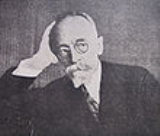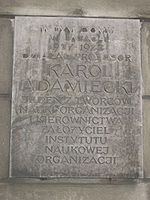
Karol Adamiecki
Encyclopedia
Karol Adamiecki was a Polish economist
, engineer
and management
researcher.
 Adamiecki graduated in engineering from the university in St. Petersburg, Russia, in 1891. He then returned to Dąbrowa Górnicza where he was in charge of a steel rolling mill. While working in the steel industry he developed his ideas on management.
Adamiecki graduated in engineering from the university in St. Petersburg, Russia, in 1891. He then returned to Dąbrowa Górnicza where he was in charge of a steel rolling mill. While working in the steel industry he developed his ideas on management.
In 1919 he joined the Warsaw Polytechnic
as a lecturer, becoming a professor
in 1922. He was the founder and first director (1925–1933) of the Institute of Scientific Organization in Warsaw. He served as vice president of the European Association of Scientific Management .
Karol Adamiecki was a prominent management researcher in Eastern and Central Europe. He began his research at the Institute of Technology in St. Petersburg
, Russia (1884–90), then moved to Poland.
In 1896 Adamiecki invented a novel means of displaying interdependent processes so as to enhance the visibility of production schedules. In 1903 his theory caused a stir in Russian technical circles. He published some articles on it in the Polish magazine Przegląd Techniczny (Technical Review), nos. 17, 18, 19 and 20 (1909). In 1931 he published a more widely-known article describing his diagram, which he called the harmonogram or harmonograf. Adamiecki had, however, published his works in Polish and Russian, languages little known in the English speaking world
. By this time, a similar method had been popularized in the West
by Henry Gantt
(who had published articles on it in 1910 and 1915). With minor modifications, Adamiecki's chart is now more commonly referred to in English as the Gantt Chart
.
Adamiecki published his first papers in management in 1898, before Frederick Winslow Taylor
had popularized scientific management
. In 1925 Adamiecki founded the Polish Institute of Scientific Management.
He did most of his research and observations in the field of metallurgy
.
 He is the author of the law of harmony in management: harmony should comprise three parts:
He is the author of the law of harmony in management: harmony should comprise three parts:
In 1972 the State College of Economic Administration in Katowice
was named after him, and in 1974 it became the Karol Adamiecki University of Economics (Polish Akademia Ekonomiczna im. Karola Adamieckiego w Katowicach).
Economist
An economist is a professional in the social science discipline of economics. The individual may also study, develop, and apply theories and concepts from economics and write about economic policy...
, engineer
Engineer
An engineer is a professional practitioner of engineering, concerned with applying scientific knowledge, mathematics and ingenuity to develop solutions for technical problems. Engineers design materials, structures, machines and systems while considering the limitations imposed by practicality,...
and management
Management
Management in all business and organizational activities is the act of getting people together to accomplish desired goals and objectives using available resources efficiently and effectively...
researcher.
Life

In 1919 he joined the Warsaw Polytechnic
Warsaw University of Technology
The Warsaw University of Technology is one of the leading institutes of technology in Poland, and one of the largest in Central Europe. It employs 2,453 teaching faculty, with 357 professors . The student body numbers 36,156 , mostly full-time. There are 17 faculties covering almost all fields of...
as a lecturer, becoming a professor
Professor
A professor is a scholarly teacher; the precise meaning of the term varies by country. Literally, professor derives from Latin as a "person who professes" being usually an expert in arts or sciences; a teacher of high rank...
in 1922. He was the founder and first director (1925–1933) of the Institute of Scientific Organization in Warsaw. He served as vice president of the European Association of Scientific Management .
Karol Adamiecki was a prominent management researcher in Eastern and Central Europe. He began his research at the Institute of Technology in St. Petersburg
Saint Petersburg State Institute of Technology
Saint Petersburg State Institute of Technology is one of the oldest institutions of higher education in Russia , it currently trains around 5000 students.-History:...
, Russia (1884–90), then moved to Poland.
In 1896 Adamiecki invented a novel means of displaying interdependent processes so as to enhance the visibility of production schedules. In 1903 his theory caused a stir in Russian technical circles. He published some articles on it in the Polish magazine Przegląd Techniczny (Technical Review), nos. 17, 18, 19 and 20 (1909). In 1931 he published a more widely-known article describing his diagram, which he called the harmonogram or harmonograf. Adamiecki had, however, published his works in Polish and Russian, languages little known in the English speaking world
Anglophone
Anglophone may refer to:*An English language-speaking person, group, or locality*English-speaking world* Anglosphere...
. By this time, a similar method had been popularized in the West
Western world
The Western world, also known as the West and the Occident , is a term referring to the countries of Western Europe , the countries of the Americas, as well all countries of Northern and Central Europe, Australia and New Zealand...
by Henry Gantt
Henry Gantt
Henry Laurence Gantt, A.B., M.E. was an American mechanical engineer and management consultant who is most famous for developing the Gantt chart in the 1910s....
(who had published articles on it in 1910 and 1915). With minor modifications, Adamiecki's chart is now more commonly referred to in English as the Gantt Chart
Gantt chart
A Gantt chart is a type of bar chart that illustrates a project schedule. Gantt charts illustrate the start and finish dates of the terminal elements and summary elements of a project. Terminal elements and summary elements comprise the work breakdown structure of the project. Some Gantt charts...
.
Adamiecki published his first papers in management in 1898, before Frederick Winslow Taylor
Frederick Winslow Taylor
Frederick Winslow Taylor was an American mechanical engineer who sought to improve industrial efficiency. He is regarded as the father of scientific management and was one of the first management consultants...
had popularized scientific management
Scientific management
Scientific management, also called Taylorism, was a theory of management that analyzed and synthesized workflows. Its main objective was improving economic efficiency, especially labor productivity. It was one of the earliest attempts to apply science to the engineering of processes and to management...
. In 1925 Adamiecki founded the Polish Institute of Scientific Management.
He did most of his research and observations in the field of metallurgy
Metallurgy
Metallurgy is a domain of materials science that studies the physical and chemical behavior of metallic elements, their intermetallic compounds, and their mixtures, which are called alloys. It is also the technology of metals: the way in which science is applied to their practical use...
.

- harmony of choice (all production tools should be mutually compatible, with special regard to their output production speed)
- harmony of doing (the importance of time coordination — schedules and timetablesSchedule (workplace)A schedule, often called a rota, is a list of employees who are working on any given day, week, or month in a workplace. A schedule is necessary for the day-to-day operation of any retail store or manufacturing facility. The process of creating a schedule is called scheduling...
) - harmony of spirit (the importance of creating a good team)
In 1972 the State College of Economic Administration in Katowice
Katowice
Katowice is a city in Silesia in southern Poland, on the Kłodnica and Rawa rivers . Katowice is located in the Silesian Highlands, about north of the Silesian Beskids and about southeast of the Sudetes Mountains.It is the central district of the Upper Silesian Metropolis, with a population of 2...
was named after him, and in 1974 it became the Karol Adamiecki University of Economics (Polish Akademia Ekonomiczna im. Karola Adamieckiego w Katowicach).
See also
- List of business theorists
- List of economists
- List of Poles

